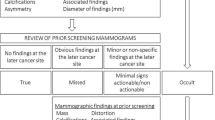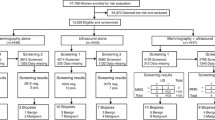Abstract
Objective
To assess the positive predictive values of incremental breast cancer detection (PPV1) in relation to the mammographic breast density and of performed biopsies (PPV3) resulting from supplemental bilateral physician-performed whole-breast ultrasound (US) at recall of a population-based digital mammography screening programme.
Methods
A total of 2,803 recalled screening participants (50–69 years), who had additional bilateral US with prospectively completed documentation [grading of breast density (ACR 1–4), biopsy recommendation related to US and mammography], were included.
Results
The PPV1 of supplemental cancer detection only by US was 0.21 % (6/2,803) compared to 13.8 % (386/2,803) by mammography. The PPV1 of US-only cancer detection was 0 %, 0.16 % (2/1,220), 0.22 % (3/1,374) and 1.06 % (1/94) for women with breast density of ACR 1, ACR 2, ACR 3 and ACR 4, respectively. The PPV3 of US-only lesion detection was 33.3 % (9/27) compared to 38.0 % (405/1,066) by mammography. The proportion of invasive cancers no larger than 10 mm was 37.5 % (3/8) for US-only detection compared to 38.4 % (113/294) for mammographic detection.
Conclusion
Bilateral ultrasound at recall, in addition to the assessment of screen-detected mammographic abnormalities, resulted in a low PPV of incremental cancer detection only by US, without a disproportional increase of false-positive biopsies.
Key Points
• Bilateral breast ultrasound was assessed in women recalled following digital mammography screening.
• Overall breast cancer detection rate reached the desired level of European guidelines.
• Additional ultrasound-only cancer detection had a low positive predictive value (0.21 %).
• Ultrasound did detect additional unexpected breast cancers in breasts graded ACR 2–4.
• Bilateral breast ultrasound offers little or only marginal benefit in routine screening.

Similar content being viewed by others
Abbreviations
- PPV1:
-
positive predictive value of breast cancer detection
- PPV3:
-
positive predictive value of performed biopsies
- US:
-
ultrasound
References
Perry N, Broeders M, de Wolf C et al (2006) European guidelines for quality assurance in breast cancer screening and diagnosis, 4th edn. Office for Official Publications of the European Communities, Luxembourg
World Health Organization and International Agency for Research on Cancer (2002) IARC handbooks of cancer prevention, vol 7: breast cancer screening. IARC, Lyon. Available via http://www.iarc.fr/en/publications/pdfs-online/prev/handbook7/Handbook7_Breast-0.pdf. Accessed 10 Jan 2012
US Preventive Services Task Force (2009) Screening for breast cancer: US Preventive Services Task Force recommendation statement. Ann Intern Med 151:716–726
Porter GJ, Evans AJ, Cornford EJ et al (2007) Influence of mammographic parenchymal pattern in screening-detected and interval invasive breast cancers on pathologic features, mammographic features, and patient survival. AJR Am J Roentgenol 188:676–683
Mandelson MT, Oestreicher N, Porter PL et al (2000) Breast density as a predictor of mammographic detection: comparison of interval- and screen-detected cancers. J Nat Cancer Inst 92:1081–1087
Boyd NF, Guo H, Martin LJ et al (2007) Mammographic density and the risk and detection of breast cancer. N Engl J Med 356:227–236
Berg WA, Blume JD, Cormack JB et al (2008) Combined screening with ultrasound and mammography vs mammography alone in women at elevated risk of breast cancer. JAMA 299:2151–2163
Berg WA, Gutierrez L, NessAiver MS et al (2004) Diagnostic accuracy of mammography, clinical examination, US, and MR imaging in preoperative assessment of breast cancer. Radiology 233:830–849
Kolb TM, Lichy J, Newhouse JH (2002) Comparison of the performance of screening mammography, physical examination, and breast US and evaluation of factors that influence them: an analysis of 27,825 patient evaluations. Radiology 225:165–175
McCavert M, O’Donnell ME, Aroori S et al (2009) Ultrasound is a useful adjunct to mammography in the assessment of breast tumours in all patients. Int J Clin Pract 63:1589–1594
Corsetti V, Houssami N, Ghirardi M et al (2011) Evidence of the effect of adjunct ultrasound screening in women with mammography-negative dense breasts: interval breast cancers at 1 year follow-up. Eur J Cancer 47:1021–1026
Kaplan SS (2001) Clinical utility of bilateral whole-breast US in the evaluation of women with dense breast tissue. Radiology 221:641–649
Crystal P, Strano SD, Shcharynski S, Koretz MJ (2003) Using sonography to screen women with mammographically dense breasts. AJR Am J Roentgenol 181:177–182
Buchberger W, Niehoff A, Obrist P, DeKoekkoek-Doll P, Dünser M (2000) Clinically and mammographically occult breast lesions: detection and classification with high-resolution sonography. Semin Ultrasound CT MRI 21:325–336
Albert US, Altland H, Duda V et al (2009) 2008 update of the guideline: early detection of breast cancer in Germany. J Cancer Res Clin Oncol 135:339–354
Bevers TB, Anderson BO, Bonaccio E et al (2009) NCCN clinical practice guidelines in oncology: breast cancer screening and diagnosis. J Natl Compr Cancer Netw 7:1060–1096
D’Orsi CJ, Bassett LW, Berg WA et al (2003) Breast Imaging Reporting and Data System: ACR BI-RADS—mammography, 4th edn. American College of Radiology, Reston
Ciatto S, Visioli C, Paci E, Zappa M (2004) Breast density as a determinant of interval cancer at mammographic screening. Br J Cancer 90:393–396
Nothacker M, Duda V, Hahn M et al (2009) Early detection of breast cancer: benefits and risks of supplemental breast ultrasound in asymptomatic women with mammographically dense breast tissue. A systematic review. BMC Cancer 9:335
Leconte I, Feger C, Galant C et al (2003) Mammography and subsequent whole-breast sonography of nonpalpable breast cancers: the importance of radiologic breast density. AJR Am J Roentgenol 180:1675–1679
Corsetti V, Houssami N, Ferrari A et al (2008) Breast screening with ultrasound in women with mammography-negative dense breasts: evidence on incremental cancer detection and false positives, and associated cost. Eur J Cancer 44:539–544
Pisano ED, Gatsonis C, Hendrick E et al (2005) Diagnostic performance of digital versus film mammography for breast-cancer screening. N Engl J Med 353:1773–1783
Törnberg S, Kemetli L, Ascunce N et al (2010) A pool analysis of interval cancer rates in six European countries. Eur J Cancer Prev 19:87–93
Ciatto S, Houssami N, Ambrogetti D, Bonardi R, Collini G, Del Turco MR (2007) Minority report—false negative breast assessment in women recalled for suspicious screening mammography: imaging and pathological features, and associated delay in diagnosis. Breast Cancer Res Treat 105:37–43
Lin X, Wang J, Han F, Fu J, Li A (2011) Analysis of eighty-one cases with breast lesions using automated breast volume scanner and comparison with handheld ultrasound. Eur J Radiol 81:873–878
Kavanagh AM, Byrnes GB, Nickson C et al (2008) Using mammographic density to improve breast cancer screening outcomes. Cancer Epidemiol Biomark Prev 17:2818–2824
Müller-Schimpfle MP, Heindel W, Kettritz U, Schulz-Wendtland R, Bick U (2010) Consensus meeting of course directors in breast imaging, 9 May 2009, in Frankfurt am Main—topic: masses. Rofo 182:671–675
Acknowledgments
We thank Ms. Stefanie Michalk for data retrieval.
Our co-author, Dr. Cornelis Biesheuvel, sadly passed away in March this year. We acknowledge not only his contribution to this manuscript but also the unique person, colleague and scientist he was.
Author information
Authors and Affiliations
Corresponding author
Rights and permissions
About this article
Cite this article
Weigel, S., Biesheuvel, C., Berkemeyer, S. et al. Digital mammography screening: how many breast cancers are additionally detected by bilateral ultrasound examination during assessment?. Eur Radiol 23, 684–691 (2013). https://doi.org/10.1007/s00330-012-2664-2
Received:
Revised:
Accepted:
Published:
Issue Date:
DOI: https://doi.org/10.1007/s00330-012-2664-2




